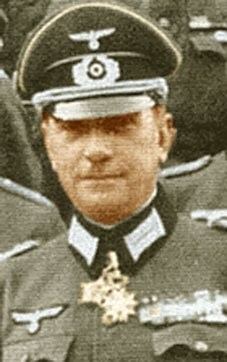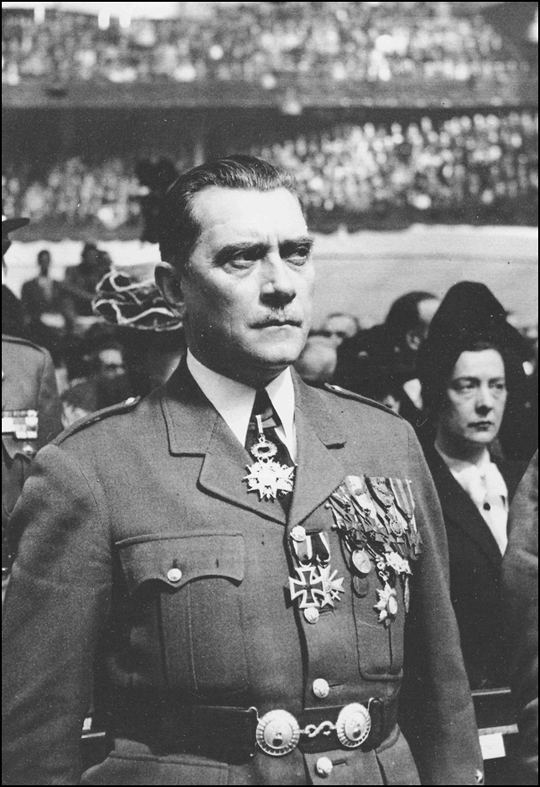Died 1945, Gryfice, Poland Name Edgar Puaud | Rank Oberfuhrer Years of service 1909–401941–45 | |
 | ||
Born 29 October 1889Orleans, France ( 1889-10-29 ) Battles/wars World War IWorld War II Commands held | ||
Edgar Joseph Alexandre Puaud (29 October 1889 – March 1945) was a French army officer, who, in 1945, briefly became commander of the Charlemagne Division, a French unit of the Waffen-SS which fought alongside the German Army against the Soviet Union.
Contents

World War I
Puaud was born in Orléans, and joined the French Army as a private soldier in 1909. By 1914 he was a sergeant, and was selected to attend the military academy at Saint-Maixent for officer training. On the outbreak of World War I, however, he and fellow "aspirants" were immediately given commissions. During the course of the war he was promoted from Sub-Lieutenant to Captain, and won the Croix de guerre and the Legion of Honour. After 1918 he served with the French army of occupation in the Rhineland, then with the French Foreign Legion in Morocco, Syria and French Indo-China.
World War II
By 1939 he was a major, based at Septfonds in the south-west of France, and as a result did not see action during the German invasion of 1940. Following the French defeat in 1940, he served in the much-reduced "Armistice Army" in Vichy France.
Although Puaud was initially hostile to French collaboration with the German occupiers, his attitude changed following the German invasion of the Soviet Union and war which ensued in June 1941. He accepted the collaborationist argument that "Bolshevism" was a greater threat to French interests than the Germans. In October 1941, he joined the Legion of French Volunteers Against Bolshevism (Legion des Volontaires Français Contre le Bolchevisme, LVF), which was fighting on the eastern front, as a battalion commander.
The LVF was not a unit of the French Army, and was not under the control of the Vichy French government. It was part of the German Army and was officially known as Infantry Regiment 638. It had two battalions of 2,271 men with 181 officers and an additional staff of 35 German officers. They fought near Moscow in November 1941 as part of the 7th Infantry Division. The LVF lost half their numbers in action or through frostbite. In 1942 the remaining men were assigned to anti-partisan duties first around Bryansk and then in Ukraine.
Appointed commander
In September 1943 Puaud, promoted to Général de Brigade (brigadier), was appointed commander of the LVF. In July 1944 the Germans decided that all foreign volunteers fighting in the German Army should be transferred to the Waffen-SS. In September 1944, a new unit, the Waffen-Grenadier-Brigade der SS "Charlemagne" was formed out of the remnants of the LVF and French Sturmbrigade, both of which were disbanded. Joining them were French collaborators fleeing the Allied advance in the west, as well as Frenchmen from the German Navy, the National Socialist Motor Corps (NSKK), the Organisation Todt and the detested Milice française security police. The formation was named after the Frankish king and German Emperor Charlemagne. Puaud was given the Waffen-SS rank Oberführer. Although Puaud was the official commander, actual control was exercised by SS-Brigadeführer Gustav Krukenberg, who spoke fluent French. Puaud and other former French Army officers were unhappy at the incorporation of the Milice members, who had a reputation for undisciplined violence but little military training.
After spending late 1944 training, the Charlemagne Brigade was upgraded to a division, with the title 33 Waffen-Grenadier-Division der SS "Charlemagne" (französische Nr 1), In February 1945, because the Germans would not have a foreigner commanding a division, Krukenberg became the official commander with Puaud as the senior French officer.
1945
In February 1945 the division was sent into action against the advancing Red Army in Pomerania. It saw action around Hammerstein, Köslin (Koszalin) and Kolberg (Kołobrzeg) on the Baltic coast. The Soviet forces split the French force into three pockets. One group commanded by Krukenberg survived. It was evacuated from the coast by the German Navy to Denmark and later sent to Neustrelitz for refitting; the second group with Puaud was destroyed by Soviet artillery and the third group tried fighting its way back westward, but by 17 March all had been captured or killed in action. Puaud was severely wounded in the fighting. He was taken to Greifenberg (Gryfice), where he was left in an inn with other wounded soldiers. There he either died of his wounds or was executed by the Soviets after they captured the town. His exact fate is not known.
